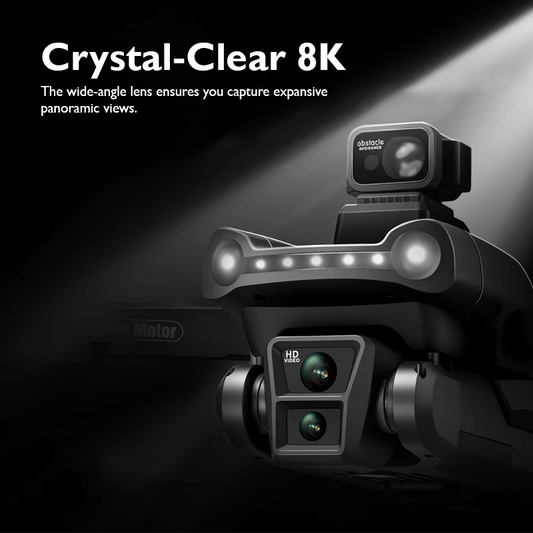Advancements in Drone Navigation Systems

In recent years, the drone industry has witnessed unprecedented growth, with applications ranging from aerial photography to surveillance and even delivery services. A key driver behind this surge in popularity is the continuous evolution of drone technology, particularly in the realm of navigation systems. As drones become more integrated into our daily lives, the demand for efficient and advanced navigation systems has never been higher. In this article, we'll delve into the cutting-edge advancements in drone navigation systems that are propelling these unmanned aerial vehicles to new heights.
1.GPS Enhancement: The Bedrock of Drone Navigation

Global Positioning System (GPS) has been the cornerstone of drone navigation for years, providing accurate location data essential for safe and precise flights. However, recent advancements have taken GPS capabilities to the next level. Differential GPS (DGPS) has emerged as a game-changer, offering enhanced positioning accuracy by correcting GPS signals in real-time. This improvement is crucial for tasks that demand centimetre-level precision, such as agricultural drone applications and infrastructure inspections.
2.Machine Learning and Artificial Intelligence: Transforming Navigation Intelligence
The integration of machine learning (ML) and artificial intelligence (AI) has ushered in a new era of intelligent drone navigation. These systems can now adapt to changing environments, learn from past flights, and make real-time decisions to optimise routes. AI algorithms enable drones to avoid obstacles, navigate complex terrains, and even predict potential hazards. This not only enhances safety but also opens up possibilities for autonomous drone operations in various industries.
3.LiDAR Technology: Mapping the Future of Drone Navigation

Light Detection and Ranging (LiDAR) technology have become instrumental in drone navigation, especially in scenarios where traditional sensors fall short. LiDAR-equipped drones use laser beams to create highly accurate 3D maps of their surroundings. This detailed mapping allows for precise obstacle detection and avoidance, making it an invaluable tool for applications like surveying, mapping, and infrastructure inspection. The ability to navigate through complex environments with heightened accuracy positions LiDAR as a transformative technology in the drone industry.
4.Visual SLAM: Navigating Through the Eyes of Drones
Simultaneous Localization and Mapping (SLAM) technology, combined with visual data, has empowered drones to navigate in real-time without the reliance on external signals. Visual SLAM enables drones to create maps of their surroundings using onboard cameras, all while determining their position within those maps. This technology is particularly beneficial in scenarios where GPS signals may be weak or unavailable, such as indoor environments or urban canyons. As drones continue to evolve beyond open skies, Visual SLAM paves the way for increased versatility and adaptability.
5.Swarm Intelligence: Collaborative Navigation Takes Flight

The concept of swarm intelligence involves multiple drones working together in a coordinated manner, emulating the collective behaviour observed in social organisms like ants or birds. This collaborative approach to navigation enables drones to share information, optimise routes, and operate efficiently as a group. Swarm intelligence is a breakthrough in applications such as search and rescue missions, environmental monitoring, and large-scale aerial displays. As this technology matures, the possibilities for synchronised drone operations become increasingly exciting.
6.5G Connectivity: Real-time Communication for Enhanced Navigation

The rollout of 5G networks has significant implications for drone navigation. With faster and more reliable connectivity, drones can transmit and receive data in real-time, enabling seamless communication between the drone and ground control. This is particularly crucial for applications that require low-latency communication, such as remote piloting, emergency response, and surveillance. The integration of 5G technology not only enhances navigation but also expands the scope of drone applications in various industries.
7.Weather Adaptive Systems: Navigating the Storm

Weather conditions pose a considerable challenge to drone navigation. However, recent advancements in weather adaptive systems have equipped drones to handle adverse weather scenarios more effectively. These systems leverage real-time weather data to adjust flight parameters, ensuring safe and stable operations even in challenging conditions. As a result, drones are becoming more reliable for tasks like aerial inspections during inclement weather, providing a competitive edge in industries where weather resilience is paramount.
8.Energy-Efficient Navigation: Prolonging Flight Times

One of the limitations in drone technology has been the finite flight time due to battery constraints. However, advancements in energy-efficient navigation systems are addressing this challenge. Drones are now equipped with predictive algorithms that optimise energy consumption, allowing for longer flight durations. This is particularly advantageous for applications like surveillance, where extended flight times are essential. Energy-efficient navigation systems contribute not only to increased operational efficiency but also to a reduction in the environmental footprint of drone operations.
The advancements in drone navigation systems are transforming the capabilities and applications of unmanned aerial vehicles. From enhanced GPS accuracy to the integration of AI and machine learning, drones are becoming more intelligent and versatile. LiDAR and Visual SLAM technologies are revolutionising how drones perceive and navigate their surroundings, while swarm intelligence and 5G connectivity open up new possibilities for collaborative and real-time operations.
As the drone industry continues to soar to new heights, these advancements in navigation systems are key drivers of innovation. Whether it's for precision agriculture, infrastructure inspection, or emergency response, the evolving landscape of drone navigation ensures that these unmanned aerial vehicles can navigate through challenges and deliver reliable performance in diverse scenarios. As we look to the future, the synergy of these technologies promises a new era of drone applications that were once only imaginable in science fiction.
Explore a variety of drones at our online drone store.
Happy Flying!









